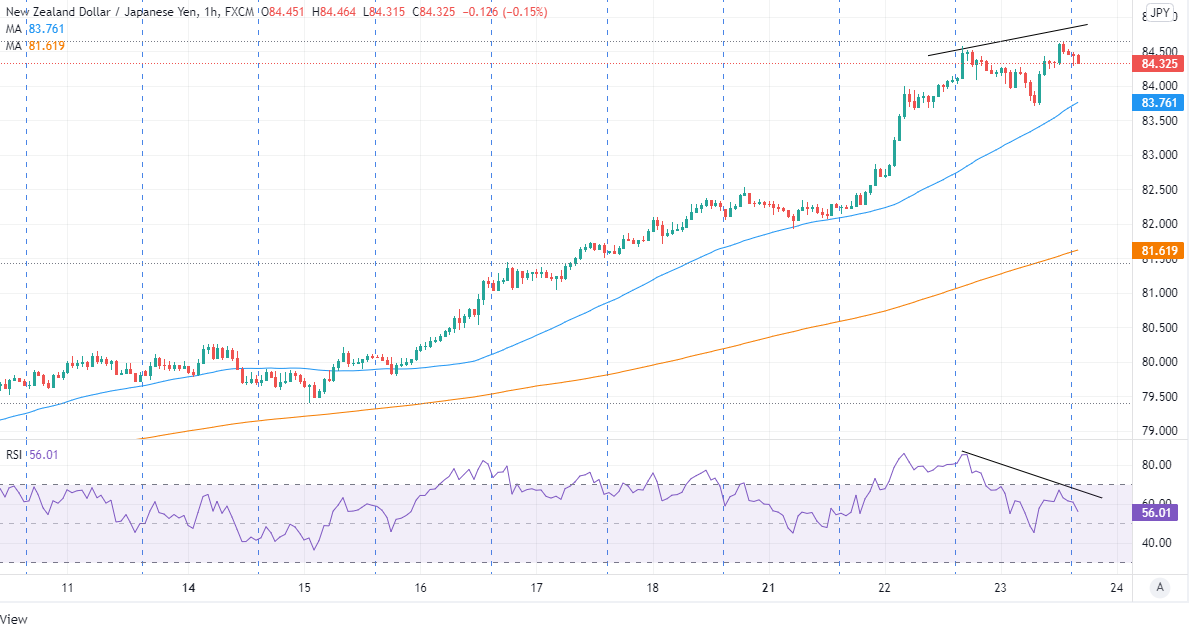- Analytics
- News and Tools
- Market News
- NZD/JPY Price Analysis: Golden cross in the daily chart opens the door for 85.00 and beyond
NZD/JPY Price Analysis: Golden cross in the daily chart opens the door for 85.00 and beyond
- The NZD/JPY March rally has gained 8.48% in the month.
- NZD/JPY Price Forecast: A breach of the 85.00 mark would expose levels not seen since July 2015.
The New Zealand dollar extended its rally vs. the Japanese yen for the second time in the week, despite a downbeat market mood courtesy of tensions in Eastern Europe. As the Asian Pacific session is about to kick in, the NZD/JPY trades at 84.43 at the time of writing.
US equities finished Wall Street’s trading session with losses. In the meantime, the greenback traded firmly, as portrayed by the US Dollar Index rising 0.20% at 98.612, while the US Treasuries sell-off stalled, with yields down.
The NZD/JPY pair is a cross-currency pair traded mainly as pure market sentiment play. However, it appears to be decoupled from a positive correlation with the S&P 500. Since mid-February of 2022, the S&P 500 began sliding, as the US central bank turned hawkish, while the NZD/JPY began its 800 pip rally, from around 76.00 towards 84.00

Overnight, the NZD/JPY began on a higher note, around 84.00-30, reaching a daily low at 83.70. Late in the New York session, staged a rebound achieving a YTD high at 84.64, despite the negative divergence between NZD/JPY’s price action and the Relative Strength Index (RSI), a momentum indicator in the 1-hour chart.

NZD/JPY Price Forecast: Technical outlook
The NZD/JPY daily chart depicts the pair as upward biased. Furthermore, the 50-day moving average (DMA) at 78.12 just crossed over the 200-DMA at 78.04, forming a golden cross, which means the NZD/JPY is ready to make new highs unless a sudden market sentiment increases appetite for safe-haven peers.
With that said, the NZD/JPY’s first resistance would be the 85.00 mark. A breach of the latter would expose the April 2013 high at 86.41, followed by April 2014 at 89.92, and the 90.00 mark.

© 2000-2024. All rights reserved.
This site is managed by Teletrade D.J. LLC 2351 LLC 2022 (Euro House, Richmond Hill Road, Kingstown, VC0100, St. Vincent and the Grenadines).
The information on this website is for informational purposes only and does not constitute any investment advice.
The company does not serve or provide services to customers who are residents of the US, Canada, Iran, The Democratic People's Republic of Korea, Yemen and FATF blacklisted countries.
Making transactions on financial markets with marginal financial instruments opens up wide possibilities and allows investors who are willing to take risks to earn high profits, carrying a potentially high risk of losses at the same time. Therefore you should responsibly approach the issue of choosing the appropriate investment strategy, taking the available resources into account, before starting trading.
Use of the information: full or partial use of materials from this website must always be referenced to TeleTrade as the source of information. Use of the materials on the Internet must be accompanied by a hyperlink to teletrade.org. Automatic import of materials and information from this website is prohibited.
Please contact our PR department if you have any questions or need assistance at pr@teletrade.global.















